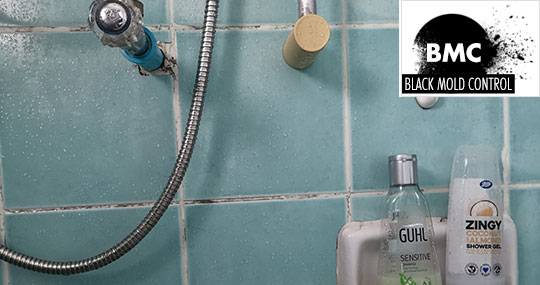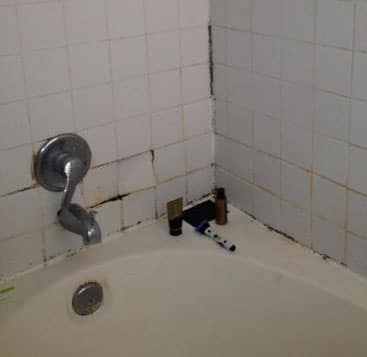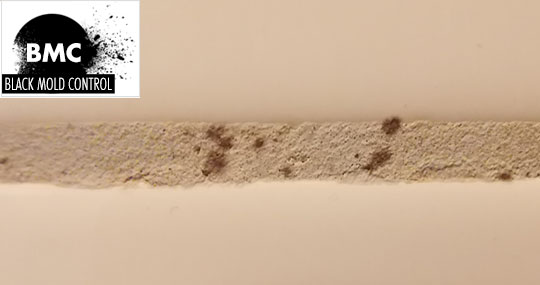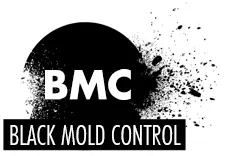Do you have black mold in bathroom? One of the areas in your home where the conditions for black mold growth are at their best, is without a doubt your bathroom. This moisture filled room is exceptionally great for black mold to thrive, because all the elements that fungus needs to grow come together in high frequency.
In this place meant for personal hygiene, the last thing you want to be confronted with, is this nasty black substance. For this reason we composed this guide, which will help you remove bathroom mold and prevent further growth.
Table of Contents
- What causes black mold
- Is bathroom mold dangerous?
- Where to find mold in your bathroom
- Gear for bathroom mold removal
- Removal black mold in bathroom
- How to prevent bathroom mold
- How to remove mold from bathroom tiles
- Natural ways to clean bathroom tiles
- Best bathroom tile cleaners on Amazon
- How to remove mold from bathroom grout
- How to remove mold from bathroom ceiling

What causes black mold in bathrooms?
Black mold often occurs in poorly ventilated bathrooms which haven’t been cleaned on a regular basis, which lead to optimum conditions for mold growth. Their are 5 specific elements that need to be present for black mold to grow: mildew spores, a food source, a place to grow, a source of moisture and oxygen.
Next to these necessary elements, there are some factors that increase the growth, namely: adequate heat, high humidity, sufficient time and minimal light. When you look at the factors listed above you will notice that a bathroom meets all the required aspects for mildew to grow and even meets all the factors that increase its growth substantially.
Molds spread by producing microscopic spores. These spores travel through the air until they find a damp area to grow. Most of the time, this isn’t a problem. Unfortunately, when these spores land on your damp shower tile, they can begin to grow inside your home.
Before removing this fungus, you need to determine why it grew. Is there a leak in your bathroom that is feeding the fungus? Is the room not ventilated properly? Determine wear the excess moisture is coming from and fix the problem before attacking the fungus. If you fail to fix the source of the problem, the fungus will keep on coming back.
For more in-depth information, make sure you read our guide: causes of black mold growth.
Is black mold in your bathroom dangerous?
If you’ve found black mold or Satchybotrys chararum, in your bathroom, it is quite dangerous. This type of mold is unfortunately common in areas like the shower, ceiling, bathtub, tile, and toilet of your bathroom. These spores cause serious health issues to humans and require immediate removal. If you interact with this kind, you may experience black mold poisoning and its symptoms.
How about the health risks?
Black mold is especially threatening to you and poses many health risks. You should consider removal as soon as possible. With these spores, you may experience the following:
- Respiratory issues
- Nausea
- Headaches
- Skin irritation
- Asthma
- Memory loss
- Allergic reactions
Any of the above symptoms are signs that you have been exposed to toxic black mold. If you feel you’ve been affected by these health risks, seek treatment immediately.

Where can you find black mold in your bathroom?
These spores aren’t often easily detectable if you aren’t looking for them. You’ll want to do a thorough search of your shower, ceiling, bathtub, toilet, and tile, as well as every wall in the room.
Be sure to look in the following places:
Anywhere with a musty smell
Look for areas where there may be water damaged or wherever there is a “musty” smell. This usually is an indication of rotting wood which is typically a home for mold and will require immediate removal.
Your bathroom and shower tiles
When looking for spores, monitor your tiles as well. If they have a muddy appearance and are particularly wet and slimy, it is likely that spores have started growing on them.
Damaged floors or walls
Any floors, tile, or walls that feel soft or spongy are likely compromised by mold. This requires a professional to help with water damage restoration, as well as mold removal.
Visible spores
If you see spores, it is likely that there is more than meets the eye. You likely have a severe problem if you can already see the black spores.
Protective gear for bathroom mold removal
Before you remove black mold, you will need to gather a few supplies. Remember that this mould can irritate skin and eyes, as well as cause respiratory problems and fever-like symptoms. You need to protect yourself throughout the process.
Before cleaning your bathroom, you will need:
- Paper towels or old rags
- Gloves
- Trash bags
- Bleach
- Ammonia-free household cleaner
- Spray bottle
- Scrubbing brush
- Large plastic sheet
- Tape
- Gloves
- Goggles
- Dehumidifier
- HEPA, or High-Efficiency Particulate Air, vacuum
A HEPA vacuum is an extremely effective vacuum that eliminates microscopic spores and other particles. You want to make sure that you get rid of all of the spores so the mold doesn’t grow back. To find out where you can rent this equipment, call the Local Health Department. If you can’t find a HEPA vacuum, refrain from using a regular vacuum. Most household vacuums will just blow the spores around, which can make the problem worse.
Once you have organized your supplies, mix one ounce of bleach into two cups of water. Pour the solution into one of the spray bottles. Prepare the bathroom by closing the door and taping the plastic over the door. Make sure that the door jam is completely covered. This will keep the mold spores from spreading to other rooms while you clean. Also turn on the dehumidifier. This will eliminate moisture in the air throughout and after the cleaning process. Once this is done, you are ready to start cleaning your tile.
Best way to remove black mold in bathroom
 If you’ve found black mold spores in your bathroom, you’ll want to perform removal immediately. If you have a huge problem, you need to bring in an expert to ensure that all the mold is removed properly.
If you’ve found black mold spores in your bathroom, you’ll want to perform removal immediately. If you have a huge problem, you need to bring in an expert to ensure that all the mold is removed properly.
If you find that you have a small amount of black spores on your shower, ceiling, bathtub, tile, and toilet, you can likely take care of it yourself. While you can use household cleaners to remove spores, if you want to get rid of it naturally use the following methods:
- Tea tree oil
- Vinegar
- Hydrogen Peroxide
By mixing tea tree oil with water, you’ll be ale to spray the mixture onto the spores. Once the mixture has set for several hours, you should be able to scrub away the mold.If you finish the tea tree oil, complete the job using baking soda. Read about tea tree oil and fungal contamination.
Vinegar can be used straight from your bottle and sprayed on the affected area. You can finish the removal by adding in baking soda.
A teaspoon of hydrogen peroxide and water can be used to remove spores. It should stay on the moldy surface for 10 minutes. Wipe the surface off using baking soda and more hydrogen peroxide.
How to remove mold from bathroom tiles?
Black mold is a type of fungus that grows in damp, poorly ventilated areas. This fungus is frequently seen growing in bathrooms and can cause several health problems, including respiratory problems, cold-like symptoms, skin irritation, eye irritation, and asthma attacks. If left alone for too long, you may even end up developing an allergy. This is why it is so important to remove black mold from your bathroom tile.
Step 1: Remove black mold by spraying household cleaner on the area. Scrub until you have removed the visible fungus. Wipe away the grime and place the towels in a trash bag. Repeat as necessary.
Step 2: Once you have removed the visible black mold, spray the bleach solution on the area. Let the solution sit for about 15 minutes. Bleach is a fungicide and will help to kill any remaining microorganisms.
Step 3: Wipe away bleach solution and place towels in a trash bag. Make sure to tightly close the bag after filling it with infected towels.
Step 4: Pat the entire area dry. The dehumidifier will also help eliminate moisture. Do not use a fan, as this may spread mould spores.
Step 5: Once the tile is dry, use the HEPA vacuum on the tile. Vacuum each square foot of tile for about one minute.
Step 6: Immediately after finishing, place the vacuum bag into a trash bag.

5 natural ways to clean bathroom tiles
One of the biggest enemies as a home owner is mold. Removing mold safely from your home doesn’t sound like a simple task, especially if you have children or pets in the home that you need to protect from harsh chemicals. Bathrooms are one of the most common places for this troublesome fungus to grow because of the warmth and moisture. If you’re searching for a safe and effective mold remover for your bathroom, just keep reading.
- Using a mixture of half vinegar and half water, you can effectively clean your bathroom tile as well as the counters, soap scum in the bath or shower, and the front of your cabinets.
- A paste made from water and baking soda is another easy, natural, and effective cleaner to remove mold from your bathroom tile.
- A great mold removal treatment is to use a solution of two teaspoons of tea tree oil mixed with two cups of water to spray on the desired areas.
- For an extra clean look, feel, and scent, use white vinegar, rubbing alcohol, water, half a teaspoon of liquid dish soap, and a few drops of peppermint essential oils to create the ultimate cleaning solution that is still safe and natural.
- For a simple mold and mildew removal solution, simply use a mixture of half lemon juice and half baking powder.
Best bathroom tile cleaners on Amazon
Rejuvenate Scrub Free Soap Scum Remover: A safe cleaner with a simple spray and rinse formula that leaves a streak-free finish on tile, glass, plastic, chrome, and more.
Homitt Electric Spin Scrubber Power Brush: A cordless shower cleaner and scrubber that includes 3 replaceable brush heads, an extension arm, and an adapter for your tub, tile, wall, floor, and even your kitchen.
3-in-1 Grout Cleaner Brush: Deep cleaning grout remover brushes for tile lines and smaller areas.
Drillbrush: Cleaner for bathroom surfaces such as tile, tub, shower, and grout. A perfect tool that can help with mold removal and getting rid of stubborn stains.
Mold Armor: An immediate and safe mold and mildew stain remover.
What is the pink stuff on bathroom tiles?
You ask what is pink mold? The pink stuff is pink mold or Serratia marcescens is the likely culprit or the pink slime many people find in their shower. Pink mold in showers can be trouble and frustrating to deal with. It can lead to urinary tract infections and various mold allergy symptoms. This type of mold loves humid, damp places with soap scum or soap residue.
Pink mold is also very common in hospitals, fitness facilities and other places were there are a lot of showers and such. To rid your shower of pink mold the best thing you can do is clean the shower more frequently, since it is a shower you cannot eliminate the humidity or dampness, but you can eliminate the mold food. In this case the mold food is the soap scum and residue the forms from shampoo and bath and body soaps.
Bleach based cleaners work best, if that does not work you can create a borax based paste from some laundry detergents. Since some of these laundry detergents are harder to find it is recommended to try the bleach based cleaner first. Bleach will usually clean the mold issues as pink mold usually covers only a relatively small area. If you have a rather large coverage area skip the bleach and move directly to the borax based paste.
If the pink mold returns it is recommended to all a professional mold removal company to come out and analyze your mold issue, run a series of tests and come in and clean up the mold issue after properly identifying it.
If you do decide to clean up the mold yourself take the proper safety precautions or you may have to seek out hospitalization or treatment for mold exposure issues. Get the appropriate safety gear, at a minimal a disposable suit, eye protection and breathing protection. Without these basic items it is surely to cause you some mold allergies.

How to remove mold from bathroom grout?
A safe and natural grout removal process can simply be done by sprinkling some baking soda on the bathroom grout and then to spray the floor with undiluted hydrogen peroxide. After you spray over the grout, simply scrub the areas with a gentle toothbrush to finish the job. Want to know more about this subject? Take a look at our in-depth mold removal guide for grout.
How to remove black mold from bathroom ceiling?
If you have spores on your bathroom ceiling, you need to take a few more precautions. Use goggles, gloves, and a cotton face mask to help protect yourself from the spores. You can use a cleaning agent or any of the aforementioned mixtures.
It is likely that you’ll need a ladder to reach the ceiling. In the event that it cannot be removed, you may need to replace the sheet rock or wall tiles where the spores are.
These black spores are toxic and dangerous to your health. Be sure to use this guide as you monitor your bathroom for spores in the most common areas: shower, ceiling, bathtub, and toilet. Always prioritize your safety first and don’t expose yourself to unnecessary health risks. If you think you have spores that are too difficult to remove yourself, consult a professional; call for a free quote today.
How to stop mold from growing on my bathroom ceiling?
Black mold can be frustrating and hard to rid your bathroom of permanently. If the mold in your bathroom is growing on drywall the best bet is to remove the drywall in the area where the mold is growing and replace with either blue or green board. This is drywall treated with a chemical to prevent moisture and mold damage and is ideal for helping prevent bathroom ceiling mold in the future.
If you cannot remove the drywall you can try to clean the affected area by wiping it down and applying a paint that kills the mold spores and seals the area. Once this has been completed you need to prevent further mold growth by properly venting your bathroom, this can be done by slightly opening a window while showering, or running a bathroom exhaust fan while showering and for a half hour after.
You should also clean the bathroom frequently wiping down the walls, floor and shower. Keeping a well vented and clean bathroom should help prevent future mold growth. While black mold is common in the bathroom, bright pink mold is a prime candidate in the shower and on the walls of the shower. This pink mold feeds on soap and shampoo residue left from your daily showers.
Wanting to know how to remove and clean other type of ceilings from mold? Read our article: black mold on ceiling.
How to prevent future bathroom mold?
Once you are done cleaning your bathroom, change and wash the clothes you used. Also wash your cleaning supplies and dispose of the trash bags. Once the area is clean and dry, you will need to make sure that it stays that way.
Every time you take a shower, spend a minute wiping down the bathroom tiles. Also refrain from throwing moist towels or clothes where fungus may grow. After taking a shower, open a window or put on the bathroom fan to keep air circulating. It can be difficult to keep bathroom dry. If your bathroom is constantly humid, keep a dehumidifier in the room.
Warnings to keep in mind
When cleaning your bathroom tile, make sure not to mix bleach with a cleaner that contains ammonia. This may produce a toxic gas that can be extremely dangerous, especially since you will be sealing yourself in the bathroom as you clean. Also make sure to use your gloves and goggles. If you are cleaning a large amount of black mold, you may even want to get a mask. You do not want to overexposure yourself to spores while cleaning. Fortunately, when following these steps, it is possible to remove black mold and keep it from growing on bathroom tile in the future.
Bathroom mold removal and prevention guides
Black mold actually can grow in almost all areas in your bathroom, simply because the conditions are often optimal for fungus to grow. To help you remove black mildew from your bathroom and prevent it from coming back, we have listed guides that deal with mold in specific areas of your bathroom:
- Grout – Learn to remove mildew on grout in a couple of simple steps.
- Caulk – Find out how to remove mould from shower caulk with some interesting prevention tips.
- Shower Curtains – Yes, you can even remove black mold from shower curtains, without throwing them away each time you spot dirty mildew stains on them.
- Toilets – This guide will show you how to remove black mold from your toilet, including the bowl, tank and seat.
- Bathtubs – Bathtubs are excellent places for fungus to grow. Find out what the removal process is for mould from your bathtub.
- Under Sinks – Not only in your sink drain, but also under the sink is an area where mildew can be found. Once detected you can remove the fungus under a sink with the help of our instructions.
- Air Vents – Good air circulation can be great to prevent mold growth, however poorly maintained air vents and ductwork can also be a place where fungus and mildew loves to grow. Get to know in detail how to remove these mildew from air duct and vents in your bathroom.
- Carpet or Rugs – Your bathroom rug also might be affected by mould growth. This guide will help you remove mold from rugs in no time.
Guide on Black Mold Removal and Cleanup – Your one-stop guide with detailed information on the black mold removal process, including essential tips and warnings.
Once the removal process is completed and you cleaned up and disinfected the area accordingly, you want to make sure the bathroom mold doesn’t grow back anytime soon. To make sure this doesn’t happen, you can take a look at our complete guide on Black Mold Prevention. All the guides listed above contain some easy to follow prevention tips for the specific areas in your bathroom.
